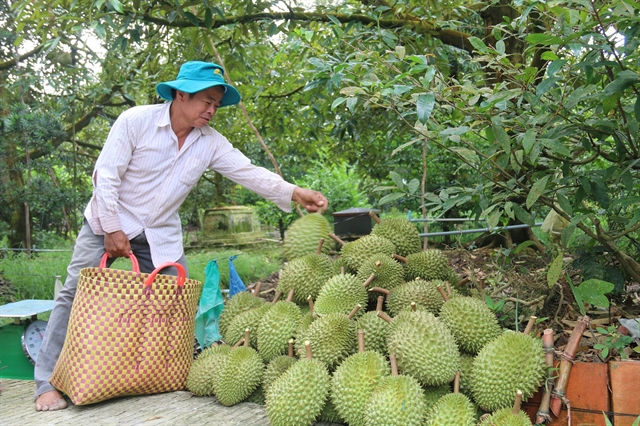 Opinion
Opinion


|
| A farmer harvests durian in the Mekong Delta province of Tiền Giang. 50 per cent of fruits for export of Việt Nam come from the Mekong Delta region. VNA/VNS Photo |
Dr. Lê Đức Thịnh, Director General of the Department of Economic Co-operation and Rural Development, under the Ministry of Agriculture and Rural Development, speaks to the newspaper Nông Thôn Ngày Nay (Countryside Today) on the need to create a chain in agriculture production in the Mekong Delta region
What’s the role of agriculture co-operatives in the Mekong Delta region?
The Mekong Delta is the biggest producer of agricultural products in Việt Nam. It is reported that up to 90 percent of the country’s rice, 50 percent of fruit and 70 percent of aqua products for export come from the region.
However, the Mekong Delta is heavily affected by the climate change. According the evaluation from many experts, Việt Nam is among the five countries seriously affected, of which the Mekong Delta suffers the most, particularly with the problems of rising sea levels, soil erosion and contamination. As a result, the number of poor households in the region is very high and the quality of human resources is low.
Among strong Vietnamese export enterprises in the fields of rice, fruits, aqua-products, many come from the Mekong Delta. Yet, none of them are from the regional farming co-operatives.
So, this is food for thought for the authorities. If these co-operatives had received due attention from the authorities, the farmers would have caught up with advanced technology to help them improve the quality of their products as well as to raise their agriculture productivities.
What’s more important, the co-operatives will be able to help the farmers find the best options to be adaptable to the climate change.
Talk a little bit about the current operational status of agriculture co-operatives in the Mekong Delta?
Before 2016, there were 1,400 co-operatives in the Mekong Delta, of which 1,250 of them operated in the field of agriculture. Some 1,000 co-operatives specialised in rice production.
However, following the Prime Minister issuance of the Decision 445 on the piloting of new life style co-operative program in the Mekong Delta, the number of co-operatives in the region has increased rapidly. In two years (2017-2018), some 502 new cooperatives were established. All the newly established co-operatives had focused their operations in certain areas, particularly in aqua-products or fruit production. Thanks to the application of advanced technology, up to 55 per cent of these co-operatives have received the title “advanced co-operatives” by the Ministry of Agriculture and Rural Development. Before 2016, on an average one co-operative in the Mekong Delta had just about 77 members, but now the number is double while their production land area increased from 87 ha to 135 ha.
What are the challenges co-operatives in the Mekong Delta have been facing?
Though the Mekong Delta is the country’s largest agricultural production area, it has not yet received due attention from the central government, particularly in the context of climate change. At present, the total area of agriculture production in the Mekong Delta is 1.7 million ha for rice cultivation; 700,000 ha for aqua production and 300,000 ha for fruit trees. We’re confident that if they will receive due attention and support from the central Government, people in the Mekong Delta will be able to profit from their land and other natural assets that nature has blessed them with._VNS